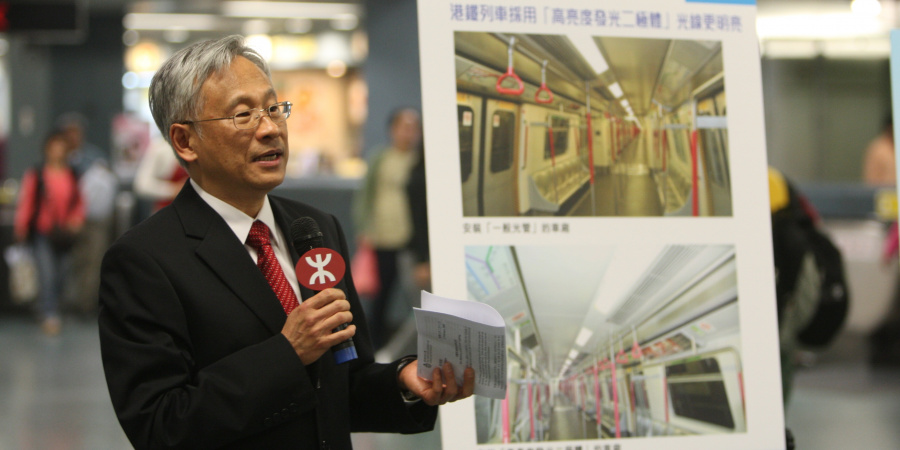HKUST Sets New Milestone in MTR “Green” Lighting
State-of-the-art High Brightness Light Emitting Diode (HD-LED) Solid State Lighting (SSL) modules jointly developed by the Hong Kong University of Science and Technology (HKUST) and the MTR Corporation are being installed on three MTR trains. The first train has been deployed this week on the Tsuen Wan Line for public transportation services, offering passengers pleasurable subway journeys with environmentally friendly high tech illumination.
According to recent research results, HD-LED SSL consumes 20%-30% less electricity than conventional lighting with fluorescent tubes. In addition, its long lasting lifespan of 50,000 hours is at least 5 times that of regular household fluorescent tubes, and 3 times that of the fluorescent tubes used on the MTR. This feature substantially reduces the cost of maintenance/replacement and the generation of waste, giving considerable benefits to environmental protection.
In October 2006, MTR collaborated with HKUST and launched the first phase trial of using HB-LED SSL modules for saloon lighting in one of its train carriages on the Tsuen Wan Line. After two years of operation, MTR was satisfied with its performance and embarked on the second phase to extend installation to three trains totaling 24 carriages, as well as to the stations.
MTR’s second phase trial of environmentally friendly saloon lighting employed the basic structure of HB-LED SSL modules developed by HKUST for the first phase. New improvements such as assembly substrates and protection circuits were implemented. Due to the substantial increase in the scale of the trial, HKUST teamed up with an industrial partner, JM Solid-State Lighting Limited under the Jiuzhou Electrical Group, to form an industrial research consortium for the implementation of the second phase trial of MTR HB-LED saloon lighting project. With the addition of the industrial partner, the new generation of SSL modules were assembled by fully automated surface mount technology. This is an essential improvement in quality assurance and reliability in mass production.
HKUST Dean of Engineering Prof Philip Chan said, “MTR is a forerunner in adopting HB-LED SSL for ‘green’ saloon lighting on subway trains. In the near future, this new technology will be extended to the general lighting in stations and the back lighting in advertising boxes. I consider it a visionary initiative. HKUST is very pleased to cooperate with MTR in applying this emerging lighting technology in public transportation services. This collaboration also sets a good example of how tertiary institutions can contribute to local industry and society.”
Prof Chan added, “SSL has major advantages such as energy saving, environmental friendliness, and long life. The advancement of HB-LED technology is ongoing. The luminous efficacy in term of lumens per watt keeps on increasing. There is still considerable room for growth in the foreseeable future. This is an emerging lighting technology worth consideration and promotion. There is no doubt that one of these days HB-LED SSL will become the main stream of general lighting in most households.”
The project leader, Prof Ricky Lee of the Department of Mechanical Engineering at HKUST, said, “The main challenge of the current project is to develop HB-LED SSL modules to overcome certain existing constraints such as limitation of space and power supply for conventional fluorescent tubes and, at the same time, to generate equivalent optical performance. In addition, the development team also has to achieve optimized energy efficiency and cost effectiveness. During the course of this project, the factors of mechanical structure, thermal management, electrical circuit, power consumption and optical performance were considered in detail. Furthermore, the reliability of the whole system needed to be analyzed and assessed carefully.”
Prof Lee added, “The current saloon lighting up-scale trial project is a good example to demonstrate how academia and industry can work together to create a win-win situation. The consortium of university and industrial partners have co-developed and implemented emerging lighting technologies to benefit the general public. I expect that after the second phase trial run, MTR will continue to up-scale and promote the applications of SSL in its domain. It is also believed that the industries in other business sectors with demands for general lighting will follow this on-going trend.”

